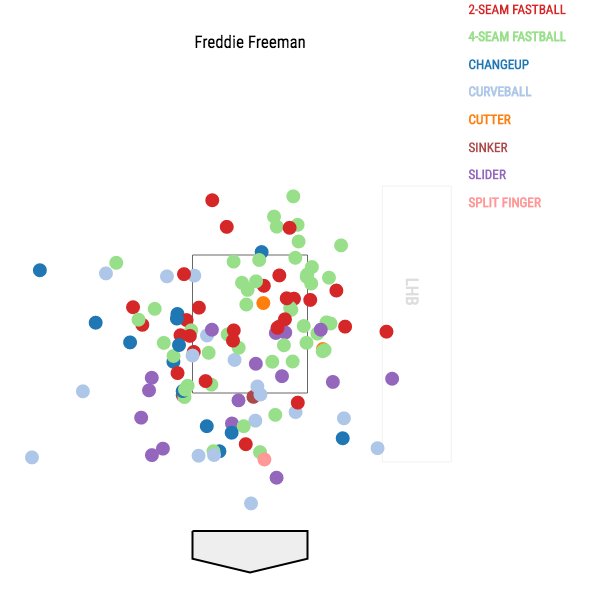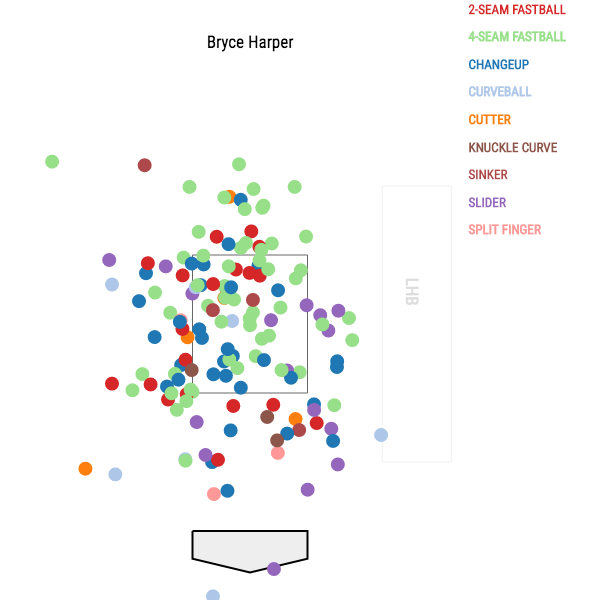(Photo by David J. Griffin/Icon Sportswire)
I will begin this article with an image because that’s a fun thing to do. As in the title, this article concerns a great hitter, Freddie Freeman, and his strike zone. This image covers those two pretty well:

That plot isn’t so easy interpret as there is a lot of stuff going on. But there is one thing that draws the eye pretty easily. That box there, the strike zone, has a lot of white space. The plot accounts for every pitch thrown to Freeman, and this early in the year there are not a lot of those. That white will fill up, eventually. However, the amount of open space in that box is incredible. It makes sense that there are a lot more pitches outside of that box than inside of it; pitchers don’t want to throw in the strike zone to great, patient hitters. Look at another great, patient leftie hitter in Bryce Harper and his strike zone plot:

Harper’s is incredibly impressive in its own right, and it is not all that easy to see the differences in the two. But there are a fair amount more dots in that box for Harper than Freeman. How about another great, patient, leftie hitter in Anthony Rizzo:

Again, I know these plots can be hard to see significant differences. But look closely inside the strike zone on all of them, and Freeman’s is undeniably unique. It’s clear what my point is. Freddie Freeman is not seeing many pitches in the strike zone. Just how few?
43.7% of pitches have been thrown in the strike zone in the league this year. Over the past five years, it has always been between 44% and 45%. Of the pitches Freeman has seen this year, 27.6% of them have come in the strike zone. That’s the most in the league, and is over 6% lower than second place. The difference between Freeman and second is the difference between second and 40th. The lowest rate of pitches seen in the zone in the past five seasons was Pablo Sandoval’s 33.1% in 2013. That’s not because opponents were scared to throw pitches to him in the strike zone – he epitomized a free swinger. In those seasons, there is only one player in the bottom-20 in zone rate who also chased at a below average clip: our friend from earlier, Harper, who did it twice in 2015 and 2016.
Well, Freeman certainly isn’t swinging at everything. Of 201 qualified hitters, his 18.5% chase rate ranks 18th. The MLB average for chasing has been around 30% the past few years. It’s only 29 plate appearances, but Freeman has put together an unbelievably good combination of patience and pitchers being terrified to throw him pitches in the strike zone. He has five extra-base hits, ten walks, and three strikeouts in those plate appearances and has already accumulated .7 WAR in six games. Let’s take a look at what Freeman did in the first game of the year, when he went 1-2 with a home run and three walks.
His first appearances came in the 1st inning against an excellent pitcher in Aaron Nola (you have probably heard a lot about him here at PL):
[gfycat data_id=”SilverAridAtlanticridleyturtle”]
Nola begins by trying to locate an inside fastball at Freeman’s knees but misses low. 1-0. Then, Nola misses his spot on another fastball and lets one get upstairs. 2-0. After giving two fastball looks, the catcher calls for a changeup low and outside to try to get a strike while keeping it away from Freeman’s bat. Now, Nola is down 3-0, but the catcher still wants a fastball low and outside. Even way down in the count, they are trying to work the edges of the zone to avoid getting burned by Freeman.
[gfycat data_id=”MessyThirstyAfricanparadiseflycatcher”]
Bottom 4, against Nola for a second time. The catcher again wants a fastball low and outside. Nola misses a bit to the outside but gets some help from the umpire. 0-1. Nola fires another fastball, this time inside. Freeman gets over the top of it and fouls it off. 0-2. Nola misses his spots again on fastballs and fires a couple high ones then misses to the outside. Freeman has worked his way back to full. He fouls off a high fastball and then gets the perfect middle-middle pitch…which he grounds out. No matter the count, the Phillies still aren’t taking any chances.
[gfycat data_id=”TepidBlaringHairstreakbutterfly”]
6th inning, facing Hoby Milner. Freeman gets caught on a check-swing on a high fastball and then fouls off another high heater. Down 0-2 for the second straight at-bat! Milner goes for the wipeout on a sweeping slider, but misses badly. He tries to get Freeman on the high fastball again but he stays alive. Milner tries to get a chase on two straight sliders but he holds. Again, for the second straight at-bat, Freeman works back from 0-2 to a full count. Milner has to go back to the fastball to get a strike, Freeman licks his lips, then launches one into right field.
[gfycat data_id=”FoolhardyWelltodoChick”]
4th at-bat, against Adam Morgan in the 8th. Morgan tries get a chase from Freeman on two great sliders just outside the zone, but he won’t chase. 2-0. Morgan tries to locate a fastball to get back in the count, but will not test the strike zone and puts one low. 3-0. A called strike fastball on a pitch out of the zone and a wicked slider in the zone knot Freeman at 3-2 for a third straight time. Morgan throws another good-looking slider on the inside of the plate but Freeman holds and trots to first for his second walk.
And, if you need any more confirmation that pitchers are scared to pitch Freeman, his final plate appearance in the 9th inning was an intentional walk. In four trips to the plate, Freeman works 24 pitches and comes out with a positive outcome three times. Of those 24 pitches, only six fell in the strike zone. The chase rate and zone rate will regress undoubtedly. But what pitchers have shown us so far is that they are downright terrified of facing Freeman. They won’t give him strikes, and he won’t swing at their non-strikes. When he has swung, he has done tons of damage. Things will look significantly different, most likely in a matter of weeks. However, the small-sample numbers that Freeman has produced, especially with regard to strikes and balls, is unfathomable.
